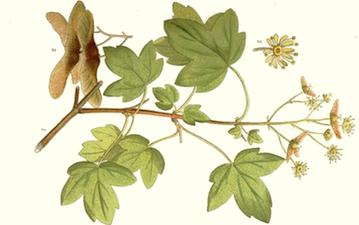Acer campestre, common name Field Maple, is a maple native to much of Europe, north to southern England (where it is the only native maple), Denmark, Poland and Belarus, and also southwest Asia from Turkey to the Caucasus, and north Africa in the Atlas Mountains.[2][3][4][5][6][7][8] In North America it is known as Hedge Maple[9][10] and in Australia it is sometimes called Common Maple.[11]
It is a deciduous tree reaching 15-25 m tall, with a trunk up to 1 m diameter, with finely fissured, often somewhat corky bark. The shoots are brown, with dark brown winter buds. The leaves are in opposite pairs, 5-16 cm long (including the 3-9 cm petiole) and 5–10 cm broad, with five blunt, rounded lobes with a smooth margin. Usually monoecious, the flowers are produced in spring at the same time as the leaves open, yellow-green, in erect clusters 4-6 cm across, and are insect pollinated. The fruit is a samara with two winged seeds aligned at 180º, each seed 8-10 mm wide, flat, with a 2 cm wing.[5][6]
There are two varieties, not accepted as distinct by all authorities:[3][5]
- Acer campestre var. campestre. Fruit downy.
- Acer campestre var. leiocarpum (Opiz) Wallr. (syn. A. campestre subsp. leiocarpum). Fruit hairless.
The closely related Acer miyabei replaces it in eastern Asia.[5]
Field Maple is an intermediate species in the ecological succession of disturbed areas; it typically is not among the first trees to colonise a freshly disturbed area, but instead seeds in under the existing vegetation. It is very shade-tolerant during the initial stages of its life, but it has higher light requirements during its seed-bearing years. It exhibits rapid growth initially, but is eventually overtaken and replaced by other trees as the forest matures. It is most commonly found on neutral to alkaline soils, more rarely on acidic soil.[8]
Diseases include a leaf spot fungus Didymosporina aceris, a mildew Uncinula bicornis, a canker Nectria galligena, and Verticillium wilt Verticillium alboatrum. The leaves are also sometimes damaged by gall mites in the genus Aceria, and the aphid Periphyllus villosus.[12]
(From Wikipedia, October 7th, 2010)
– – –




